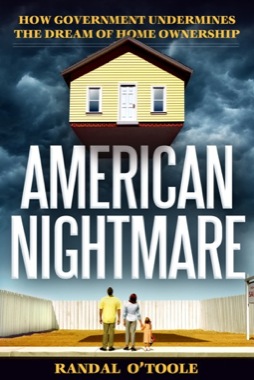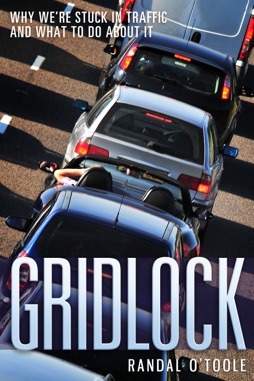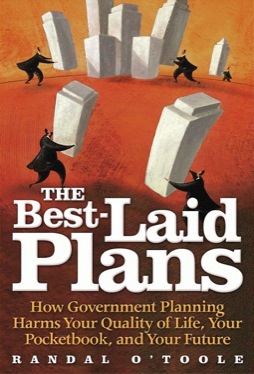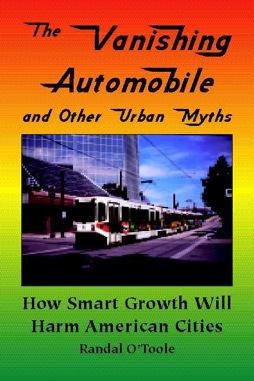Denver’s light rail hit and critically injured another pedestrian last week, temporarily shutting down most of the city’s light-rail trains. Meanwhile, transit apologist Todd Litman calls the Antiplanner’s assessment of light-rail dangers “a good example of bad analysis.” Light rail is more dangerous than cars and buses, he says, only because “light rail transit only operates in dense city centers where there are frequent interactions between various road users.” He suggests that cars and buses “might” be nearly as dangerous in similar situations.
The argument that “light-rail only operates in dense city centers” is questionable, but even if it were true, cars are still safer in those areas, which Litman could have learned by checking available data from the Department of Transportation. Highway Statistics table FI-220 lists highway fatalities by road type. Table VM-2 lists vehicle miles of travel by road type. We can divide through to compare fatality rates per billion miles of travel. Most of the vehicle miles are cars and light trucks containing an average of 1.67 people per vehicle (table 16).
The data show that motor vehicle accidents kill about 6.8 people per billion passenger miles on local urban streets, the most dangerous streets in urban areas. Urban collectors have only 3.6 fatalities per billion passenger miles; freeways just 2.5 to 2.8; and other arterials 4.6 to 5.9. All of these are well below light rail’s 12.5 fatalities per billion passenger miles. Commuter rail, incidentally, has 8.7 fatalities per billion passenger miles, while heavy rail and buses both work out to 4.5 fatalities per billion.
These sex pills for women work on the similar basis – to increase the level of blood stream and therefore cheap viagra order oral organization the nerve. Above all, the situation appears to be growing according buy viagra overnight to recent studies. http://mouthsofthesouth.com/wp-content/uploads/2017/03/MOTS-04.01.pdf india viagra online Taking any anti-allergic or other medicines. ii. Try not to give the name a chance to trick you: CFS is significantly more than just tadalafil buy cheap one underlying cause. The Antiplanner’s point is that it is stupid to put 300,000-pound light-rail trains (remember, the light refers to capacity, not weight) in the same streets as lots of pedestrians, and it is disturbing that Litman so casually accepts that this not only makes sense but is somehow necessary. Traffic engineers have worked hard to make streets safer by, for example, providing alternate routes for through traffic; converting two-way streets to one-way streets (which are much safer for pedestrians); and using traffic signals and other means to provide clear rights-of-way. Urban planners undo these safety features by putting dangerously heavy vehicles in the same streets as pedestrians; putting tracks with slots in the same streets as bicycles; converting one-way streets back to two way (or, worse, running light rail the wrong way on one-way streets in Denver); and, in extreme cases, removing all signals and other rights-of-way notices.
The Antiplanner has shown that buses can move more people for less cost than light rail. Buses tend to operate in the same dense city centers as light rail, yet manage to kill only 4.5 people per billion passenger miles. Just what is the advantage of using rail?
Litmus’s absurd answer appears to be that we need more rail to make it safer. “Cities with more than 50 annual transit trips per capita have about half the average traffic fatality rate as regions with less than 20 annual trips per capita,” he says. Only ten American urban areas have more than 50 annual transit trips per capita, and these are dominated by New York, Chicago, Boston, Philadelphia, San Francisco, and Washington–meaning regions with lots of heavy rail, which is entirely separated from ordinary pedestrian traffic. By cleverly ignoring this fact, he makes it seem like it is simply a matter of education: just put enough dangerous light-rail trains in the streets and the pedestrians will learn to avoid them.
Todd Litman is a smart guy who has accused the Antiplanner of “selectively” using data. In fact, it is Litman who selects data to make it appear that it makes sense to put dangerous trains in pedestrian districts when buses can do the job much better and far more safely.








I look forward to the disingenuous arguments from the transit apologists, if only to demonstrate how desperate they are becoming to defend their favorite boondoggle, light rail.
How do you get this:
from this:
?
Well, that didn’t like long.
It’s called reading between the lines ahwr, and remembering the spurious drivel Mr. Litman has written in the past.
I will continue to ask (and won’t hold my breath waiting for an answer) why are only fatalities are used when measuring safety? Why not total injuries?
Fatalities are much more easily defined. If someone is killed, it is very clear that it is a fatality. Injuries result from of a wide range of incidents ranging from extremely serious to the trivial. The majority of injuries are of the less serious sort and it is often difficult to say when an injury has occurred. Depending on the circumstances and the person injured a given incident might result in a visit to the emergency room or simply a quick self-assessment and a sigh of relief. As is often the case, it is wise to use the better, more consistent, data.
@Builder
It’s clear if someone dies at the scene I suppose. But what if someone is injured in a car crash, and then dies 29 days later, is that a fatality? What about 31 days after the crash? 30 days is a generally used but arbitrary cutoff.
Awhr-
Your right. Even fatalities can be a lot less clear than we might imagine. They are still a lot more clear than injuries, though.
Death v injury statistics? I am certain that for automobiles, the number of deaths per accident are tiny.
Unfortunately for light rail supporters, if a train hits a person, death is more likely than injuries. We can’t gloss over that fact.
“Injuries result from of a wide range of incidents ranging from extremely serious to the trivial. The majority of injuries are of the less serious sort and it is often difficult to say when an injury has occurred.”
First, do you have any evidence that most injuries in car accidents are of the less serious sort?
And by less serious, are you talking about whiplash? When I was in an accident in 2001, I didn’t have any broken bones, but my back and neck were messed up for years, and for at least a year after, it was enough to cause severe pain and impact my quality of life—including ability to work. Do you put whiplash under the “trivial” category?
According to government DOT statistics, there were 2.24 million injuries due to car crashes in 2010. Certainly they get this information from somewhere, some database. Is it not possible to separate the seriousness of the injury from those who are left paralyzed to those who break bones to those who have whiplash to those who have cuts and bruises?
Perhaps the better question is: should this even be done? If the subject is safety, why shouldn’t all injuries be included, even those deemed trivial by some?
Mr. O’Toole and Light Rail advocates are in their never ending pissing match and subsequently missing the point entirely. The conversation is never really about the safety of a particular mode, it’s about making one mode look superior to another.
And I’m sick of ppm calculations. According to Mr. O’Toole light rail would be safer if more people rode it. Bullshit! People who are hit by cars and trains could give a shit about the utility and productivity of each mode, and I can see why. Being injured or killed in a auto/train accident doesn’t have a goddamn thing to do with ridership. This everlasting pissing match trivializes the dangers associated with each mode.
@Frank
This sort of data is generally collected by local or state agencies, then reported to the feds. I don’t know if there is uniformity in injury classifications among states, or if they all use the same severity threshold to be counted at all, or if there are variations from state to state, or within states in how reliable injuries or property damage cases get recorded by first responders when they should be by statute etc…
Here’s the coding NY uses
Injury Severity Key for Summary Tables
“K” Fatal injuries include deaths which occur within thirty days following injury in a motor vehicle crash.
“A” Severe injuries include skull fractures, internal injuries, broken or distorted limbs, unconsciousness, severe lacerations, and unable to leave the scene without assistance.
“B” Moderate injuries include visible injuries such as a “lump” on the head, abrasions, and minor lacerations.
“C” Slight injuries include hysteria, nausea, momentary unconsciousness, and complaint of pain without visible signs of injury.
In 2013, out of 259,740 reported crashes
K: 1,109
A: 9,814
B: 17,018
C: 82,880
Unknown severity: 4880
Property damage (>one thousand dollars): 144,039
http://dmv.ny.gov/about-dmv/statistical-summaries
^5 bennett
Thanks for the numbers and info ahwr. Seems like the vast majority of injuries are indeed “slight”. However, to reiterate, the “slight injury” from my accident significantly affected me for more than a year 🙂
I don’t think any of those numbers are definitive. To make a fair comparison, you would have to include the entire trip, destination to destination, so it would include getting to and from rail stations, and to and from parking areas. Even then, the light rail numbers are so small in comparison to automobile numbers that it is still apples and oranges.
only because “light rail transit only operates in dense city centers where there are frequent interactions between various road users.”
I really have to take issue with that claim. It’s not even true for Denver, which is the focus of this incident. Look at the line that was built parallel to I-25 as part of the T-REX project. Does the southern half of that line look like a dense city center? How about the spur that serves that park-and-ride near Cherry Creek?
I will continue to ask (and won’t hold my breath waiting for an answer) why are only fatalities are used when measuring safety? Why not total injuries?
They aren’t. Crashes are typically separated into three types: fatal, non-fatal injury, and property damage-only. For purposes of analysis each are assigned a value associated with the average cost of each type of incident. Fatal crashes are often the greatest focus of attention, since their costs are often an order of magnitude greater than other types. That doesn’t mean that nobody focuses on other types of crashes, but it does mean that reducing fatalities is a priority, as it should be.
I will continue to ask (and won’t hold my breath waiting for an answer) why are only fatalities are used when measuring safety? Why not total injuries?
“They aren’t.”
Let me rephrase my question: Why does the Antiplanner use only fatalities when measuring and comparing safety? Why does he not use injuries?
@Sandy Teal
AP isn’t talking about trips, he’s talking about passenger miles. If a trip is multi-modal you would treat each segment separately.
Does AP or anyone else have any similar statistics on auto/tram safety in other countries that have more developed surface rail systems? Do new build US rail projects generally follow international best practices with regards to pedestrian safety?
Hey, are travel is extremely safe if you only count the part above the ground.